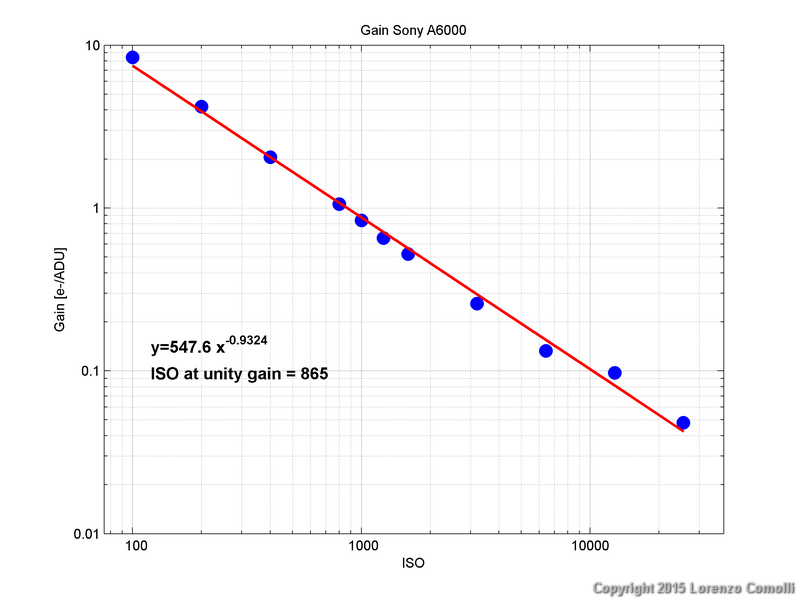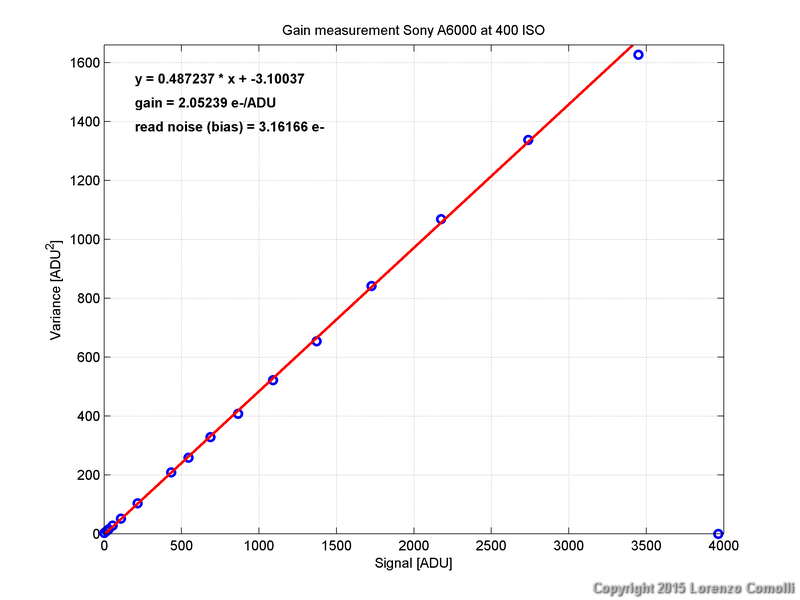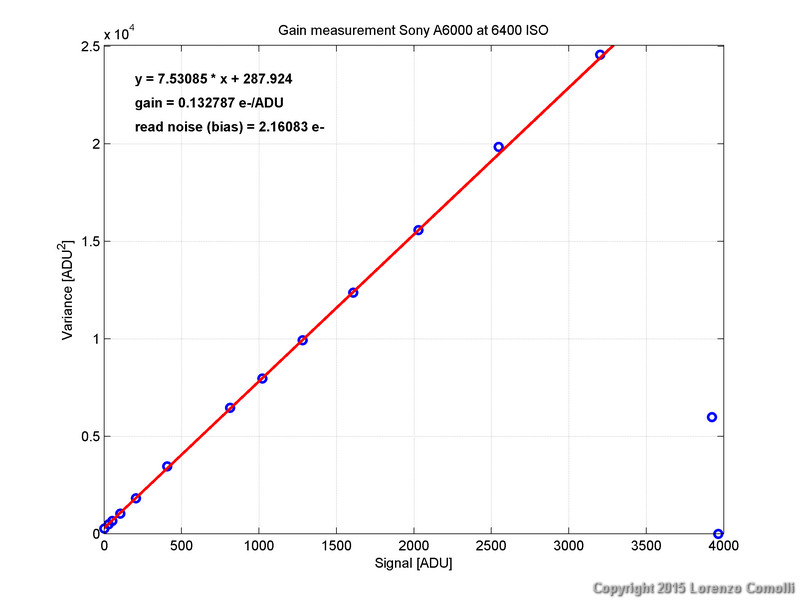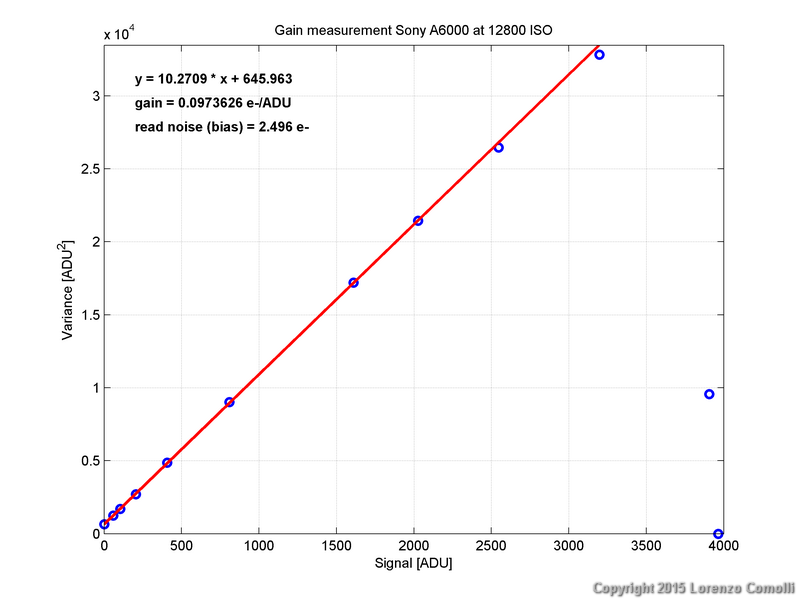|
by Lorenzo Comolli Written in August 2015 - Thanks to Emmanuele Sordini and Fabrizio Giudici for taking all the images. Thanks again to Emmanuele Sordini for the English text revisions. |

Introduction
In this page you'll find a technical test. Please refer here for an introduction, details and testing method.
Available sensitivities:
A way to distinguish between true and software-interpolated sensitivities is to look at the histogram of a nearly uniform image (like a flat field). If, however, a nonlinear compression of the histogram is applied to the raw files, then it becomes difficult to understand which sensitivities are true. That's why it is useful to look at bias data, where the raw compression is not applied because low ADU values are not subject to lossy bit-compression (see above for details). Therefore:
In this page you'll find a technical test. Please refer here for an introduction, details and testing method.
Available sensitivities:
- standard: from 100 to 25600 ISO with 1/3 EV steps
- extended: 51200 ISO with Multi-Frame NR (not tested)
-
Gain. The gains measured follow quite accurately the power law, except, although to a minor extent, for sensitivity>=12800 ISO.
- Unity gain at 865 ISO
- Read noise. Noise
decreases smoothly with increasing ISO, except at 12800 and 25600 ISO. A note about the black level clipping: with a sensitivity of 25600 ISO the foot of the histogram gets clipped because the
standard deviation of noise exceeds the offset (128 ADU), so this may lead to unreliable read
noise measurements. Therefore, I would advise against using sensitivities above 6400 ISO in raw mode,
because this will reduce dynamic range without any noticeable
improvement in the dark areas. In JPG mode or VIDEO mode, higher ISO
settings may still produce some improvements. Therefore for best results
in
extremely low-light scenes, I would recommend using 3200 to 6400 ISO.
- Dynamic range. The dynamic range is computed, taking into account the actual saturation level for each ISO setting. As shown both in the table and the charts below, the best dynamic range is obtained at 100 ISO, while higher ISO values show noticeably smaller dynamic range. The absolute value of the dynamic range is very good: 75.9 dB, or 12.7 EV. For best results in bright scenes, use 100 ISO.
- 1/3 stop sensitivities. 1/3 stop sensitivities do not seem to produce artifacts in histograms,
and this can be a sign that these ISO settings are obtained with the ADC
converter and not digitally as in the majority of the cameras I've
tested. However since the raw data is bit-compressed (see below), it is
not easy to prove this. Therefore I think all ISO settings can be used, including 1/3 stop values.
- Histograms. Light frames
at all ISO values show big gaps in their histograms. Raw values are "bit-compressed", so they are not true raw.
Here is the bit compression algorithm:
- from 0 to 800 ADU no compression (12 bit),
- from 800 to 1425 ADU take only every second value (11 bit),
- from 1425 to 2025 ADU take only every fourth value (10 bit),
- from 2025 to 4101 ADU take only every eight value (9 bit).
So a total of 1522 values are possible instead of 4096. This kind of dynamic range compression is common in some cameras such as the Sony NEX-6 and Sony A7s; it is indeed a clever way of compressing data, but in this way some of the original data is lost. In my opinion the raw file should be exactly this: RAW. If I need compression, I would select JPG or "small" raw formats. Bottom line: cameras not producing a true raw format should not be considered for serious astronomical work.
A way to distinguish between true and software-interpolated sensitivities is to look at the histogram of a nearly uniform image (like a flat field). If, however, a nonlinear compression of the histogram is applied to the raw files, then it becomes difficult to understand which sensitivities are true. That's why it is useful to look at bias data, where the raw compression is not applied because low ADU values are not subject to lossy bit-compression (see above for details). Therefore:
- values from 100 ISO up to 6400 ISO, including 1/3 stop intermediate values, are true sensitivities.
- 12800 and 25600 ISO are not true sensitivities (voids in the histogram of biases).
| ISO | gain | read noise | Dynamic range |
| [e-/ADU] | [e-] | [dB or 6*EV] |
|
| 100 | 8.41 |
5.35 |
75.9 |
| 200 | 4.20 |
3.89 | 72.6 |
| 400 | 2.05 |
3.16 | 68.2 |
| 800 | 1.06 |
2.82 | 63.5 |
| 1000 |
0.841 |
2.73 |
61.7 |
| 1250 |
0.653 |
2.56 |
60.1 |
| 1600 | 0.523 |
2.49 | 58.4 |
| 3200 | 0.259 |
2.24 | 53.2 |
| 6400 | 0.133 |
2.16 | 47.7 |
| 12800 | 0.097 |
2.50 | 43.8 |
| 25600 | 0.048 |
2.45 | 37.8 |



Histograms


Details of measurements at each ISO setting










